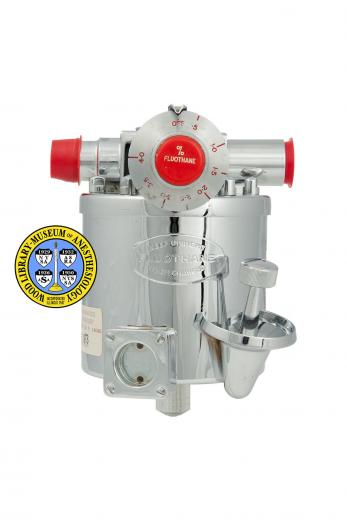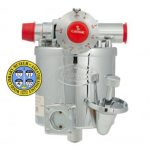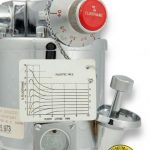Cyprane Fluotec Vaporizer
A vaporizer is a device used to convert a liquid anesthetic into a breathable form (vapor), and deliver the anesthetic vapor in specific concentrations so that controlled doses can be administered to the patient. Many variables affect the concentration produced, including the type and temperature of the liquid anesthetic, the pressures in the anesthesia system delivering the vapor, and the type and flow rate of the “carrier gases” used to produce the vapor. The carrier gas can be oxygen or a mixture of gases such as oxygen, nitrous oxide, room air, and rebreathed air.
The Fluotec vaporizer was made to administer only halothane (Fluothane). It was one of the first vaporizers made for use with only one anesthetic, and one of the first to use a bimetallic coil for temperature compensation. The bimetallic coil is part of the valve that controls how much of the carrier gas enters the vapor chamber to vaporize the anesthetic. The bimetallic coil admits more gas to the vapor chamber when the temperature decreases in order to offset the decrease in the evaporation of the liquid anesthetic that comes with cooler temperatures. Bimetallic coils are still used for this purpose in modern vaporizers. A ready reference “calibration card” came attached to the vaporizer. The card was printed with a scale that indicated the concentration of halothane produced at different flow rates and dial settings. Problems with the original Fluotec were discovered soon after its release around 1957. Cyprane quickly recalled the Fluotec, and began advertising the Fluotec Mark 2 (pictured here) in 1958.
Catalog Record: Cyprane Fluotec Vaporizer
Access Key: akfs
Accession No.: 2012-11-29-5
Title: Fluotec mark 2 / Cyprane Ltd.
Corporate Author: Cyprane Ltd.
Title variation: Alt Title
Title: Fluotec : Fluothane..
Publisher: Keighley, England : Cyprane Ltd., [1958-1975].
Physical Descript: 1 vaporizer : metals, plastic ; 16.5 x 13.5 x 17 cm.
Subject: Vaporizers.
Subject: Halothane.
Subject: Anesthesia, Inhalation – instrumentation.
Note Type: General
Notes: Title taken from tag attached to the vaporizer. Alternate title taken from
markings on vaporizer.
Note Type: Citation
Notes: Bryce-Smith R, O’Brien HD. Fluothane: a non-explosive volatile anaesthetic
agent. Br Med J. 1956;2(4999):969-972.
Note Type: Citation
Notes: Dorsch JA, Dorsch SE. Vaporizers. In: Understanding Anesthesia Equipment:
Construction, Care and Complications. 2nd ed. Baltimore: Williams & Wilkins;
1984:87-95.
Note Type: Citation
Notes: Edmondson W, Jones W, inventors; Cyprane Limited, assignee. Volatile
anaesthetic vaporising apparatus. US patent 2,915,061. December 1, 1959.
Note Type: Citation
Notes: Gartner J, Stoelting RK. A laboratory comparison of Copper Ketle, Fluotec
Mark 2, and Pentec vaporizers. Anesth Analg. 1974;53(2):187-190.
Note Type: Citation
Notes: Houghton IT. The Fluotec–early advertising. Anaesth Intensive Care.
2007;35(suppl 1):43-46.
Note Type: Citation
Notes: MacKay IM. Clinical evaluation of fluothane with special reference to a
controlled percentage vaporizer. Can Anaesth Soc J. 1957;4(3):235-245.
Note Type: Citation
Notes: Murray WJ, Fleming P. Fluotec Mark 2 halothane output: nonlinearity from off
to 0.5 percent dial setting. Anesthesiology 36: 180-181, 1972.
Note Type: Citation
Notes: Stoelting RK. The effect of nitrous oxide on halothane output from Fluotec
Mark 2 vaporizers. Anesthesiology 35: 215-218, 1971.
Note Type: Physical Description
Notes: 1 vaporizer, the outer plating of which is stainless steel or nickel; The
main body of the vaporizer is cylindrical approximately 10 cm in diameter and
9.6 cm in height; On top of the main body is T-shaped housing for the main
gas inlet (on the left back), the main outlet (back right), and a control
dial (front center); Two threaded the ‘top of the T’, extending out
horizontally, are two threaded bolts for securing the vaporizer to the
machine; A metal plate is affixed to the T; Markings on the plate include,
“FLUOTEC [new line] DISTRIBUTED BY [new line] FRASER SWEATMAN, INC., [new
line] BUFFALO, N.Y. [new line] SERIAL No. [new line] 19790 A [new line] MADE
BY [new line] CYPRANE LTD., ENGLAND. [new line] U.S.P. 2915061”; The control
dial has a red plastic face marked with “% FLUOTHANE”; Along the edge of the
circular dial are eight small notches marked with a line and number; The
numbers are, “.5”, “1.0”, “1.5”, “2.0”, “2.5”, “3.0”, “3.5”, “4.0”; There is
a large notch for the “OFF” position; behind the control know a plastic card
is attached to the vaporizer with a metal chain; The card measures
approximately 5 cm in height and 6.3 cm in width; Printed on one side of the
card is the following, “FLUOTEC MARK 2 [new line] The chart on the other side
shows typical [new line] deviations at lower flows. . . [new line] CYPRANE
LTD. KEIGHLEY [new line] ENGLAND [new line] Phone Keighley 5571”; On the
other side of the card is a chart or scale; “FLUOTEC MK.2.” is printed above
the scale; The left side of the scale is marked as “% FLUOTHANE”; Bottom of
the scale is marked “FLOW LITERS MIN”, and the right side of the scale is
marked “DIAL SET”; On the front of the vaporizer are the markings, “KEEP
UPRIGHT [new line] FLUOTHANE [new line] WHEN CHARGED”; Below and to the right
of these markings is a funnel shaped filling port with a removable screw
threaded plug; To the left of the filling port is a viewing window where the
level of liquid anesthetic may be viewed; On the left side of the body of the
vaporizer is a sticker with the following markings, “THIS VAPORIZER WAS
SERVICED [new line] AT OUR SERVICE LABORATORY [new line] 5490 BROADWAY.
LANCASTER, N. Y. 14086 [new line] ON AUG 15 1973 [new line] ANNUAL SERVICE
RECOMMENDED”; At the bottom of the vaporizer is a drain port with a removable
threaded metal cap.
Note Type: Reproduction
Notes: Photographed by Mr. Steve Donisch on January 17, 2013.
Note Type: Historical
Notes: Cyprane Limited was a British anesthetic equipment manufacturer founded by
William Edmondson and Wilfred Jones in 1949. Their first device was called
the Cyprane Inhaler, like the Duke Inhaler it was a hand-held inhaler for the
self-administration of the anesthetic trichloroethylene (Brand name Trilene)
during childbirth.
Note Type: Historical
Notes: Controlling the concentration of anesthetic in a vapor is tricky because many
variables affect the concentration produced, including the properties of the
anesthetic, temperature, pressures in the system delivering the vapor, the
type of gases in the carrier gas, and the flow rate of the carrier gas.
Cyprane developed the Fluotec vaporizer shortly after the introduction of
halothane. Unlike the Copper Kettle, which could be used to administer a
number of different anesthetic agents, the Fluotec was made to administer
only halothane (band name “Fluothane”). It was one of the first single agent
vaporizers, and one of the first to use a bimetallic coil for temperature
compensation. A ready reference “calibration card” came attached to the
vaporizer. The card was printed with a scale that indicated the concentration
of halothane produced at different flow rates and dial settings. Problems
with the Fluotec were discovered soon after its release around 1957. Cyprane
quickly recalled the Fluotec, and released the Fluotec Mark 2 in 1958. It was
much easier to use than the Copper Kettle and quickly became a favored
vaporizer on both sides of the Atlantic.
Note Type: Publication
Notes: Brennan HJ, Hunter AR, Johnstone M. Halothane: a clinical assessment. Lancet.
1957 Sep 7;273(6993):453-457.
Note Type: Exhibition
Notes: Selected for the WLM website.



